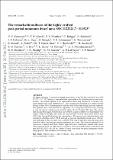| dc.contributor.author | Neustroev, V. V. | |
| dc.contributor.author | Marsh, T. R. | |
| dc.contributor.author | Zharikov, S. V. | |
| dc.contributor.author | Knigge, C. | |
| dc.contributor.author | Kuulkers, E. | |
| dc.contributor.author | Osborne, J. P. | |
| dc.contributor.author | Page, K. L. | |
| dc.contributor.author | Steeghs, D. | |
| dc.contributor.author | Suleimanov, V. F. | |
| dc.contributor.author | Tovmassian, G. | |
| dc.contributor.author | Breedt, E. | |
| dc.contributor.author | Frebel, Anna L. | |
| dc.contributor.author | García-Díaz, Ma. T. | |
| dc.contributor.author | Hambsch, F.-J. | |
| dc.contributor.author | Jacobson, Heather | |
| dc.contributor.author | Parsons, S. G. | |
| dc.contributor.author | Ryu, T. | |
| dc.contributor.author | Sabin, L. | |
| dc.contributor.author | Sjoberg, G. | |
| dc.contributor.author | Miroshnichenko, A. S. | |
| dc.contributor.author | Reichart, D. E. | |
| dc.contributor.author | Haislip, J. B. | |
| dc.contributor.author | Ivarsen, K. M. | |
| dc.contributor.author | LaCluyze, A. P. | |
| dc.contributor.author | Moore, J. P. | |
| dc.date.accessioned | 2019-06-24T15:54:17Z | |
| dc.date.available | 2019-06-24T15:54:17Z | |
| dc.date.issued | 2017-05 | |
| dc.date.submitted | 2016-05 | |
| dc.identifier.issn | 0035-8711 | |
| dc.identifier.issn | 1365-2966 | |
| dc.identifier.uri | https://hdl.handle.net/1721.1/121391 | |
| dc.description.abstract | We report extensive 3-yr multiwavelength observations of the WZ Sge-type dwarf nova SSS J122221.7-311525 during its unusual double superoutburst, the following decline and in quiescence. The second segment of the superoutburst had a long duration of 33 d and a very gentle decline with a rate of 0.02 mag d-1, and it displayed an extended post-outburst decline lasting at least 500 d. Simultaneously with the start of the rapid fading from the superoutburst plateau, the system showed the appearance of a strong near-infrared excess resulting in very red colours, which reached extreme values (B - I ≃ 1.4) about 20 d later. The colours then became bluer again, but it took at least 250 d to acquire a stable level. Superhumps were clearly visible in the light curve from our very first time-resolved observations until at least 420 d after the rapid fading from the superoutburst. The spectroscopic and photometric data revealed an orbital period of 109.80 min and a fractional superhump period excess ≲0.8 per cent, indicating a very low mass ratio q ≲ 0.045. With such a small mass ratio the donor mass should be below the hydrogen-burning minimum mass limit. The observed infrared flux in quiescence is indeed much lower than is expected from a cataclysmic variable with a nearmain- sequence donor star. This strongly suggests a brown-dwarf-like nature for the donor and that SSS J122221.7-311525 has already evolved away from the period minimum towards longer periods, with the donor now extremely dim. Keywords: binaries: close; stars: evolution; stars: individual: SSS J122221.7−311525; novae; cataclysmic variables | en_US |
| dc.publisher | Oxford University Press (OUP) | en_US |
| dc.relation.isversionof | http://dx.doi.org/10.1093/MNRAS/STX084 | en_US |
| dc.rights | Creative Commons Attribution-Noncommercial-Share Alike | en_US |
| dc.rights.uri | http://creativecommons.org/licenses/by-nc-sa/4.0/ | en_US |
| dc.source | arXiv | en_US |
| dc.title | The remarkable outburst of the highly-evolved post period-minimum dwarf nova SSS J122221.7−311525 | en_US |
| dc.type | Article | en_US |
| dc.identifier.citation | Neustroev, V. V. et al. “The Remarkable Outburst of the Highly-Evolved Post Period-Minimum Dwarf Nova SSS J122221.7−311525.” Monthly Notices of the Royal Astronomical Society (January 2017): stx084 © 2017 The Authors | en_US |
| dc.contributor.department | Massachusetts Institute of Technology. Department of Physics | en_US |
| dc.contributor.department | MIT Kavli Institute for Astrophysics and Space Research | en_US |
| dc.relation.journal | Monthly Notices of the Royal Astronomical Society | en_US |
| dc.eprint.version | Author's final manuscript | en_US |
| dc.type.uri | http://purl.org/eprint/type/JournalArticle | en_US |
| eprint.status | http://purl.org/eprint/status/PeerReviewed | en_US |
| dc.date.updated | 2019-03-22T13:56:23Z | |
| dspace.orderedauthors | Neustroev, V. V.; Marsh, T. R.; Zharikov, S. V.; Knigge, C.; Kuulkers, E.; Osborne, J. P.; Page, K. L.; Steeghs, D.; Suleimanov, V. F.; Tovmassian, G.; Breedt, E.; Frebel, A.; García-Díaz, Ma. T.; Hambsch, F.-J.; Jacobson, H.; Parsons, S. G.; Ryu, T.; Sabin, L.; Sjoberg, G.; Miroshnichenko, A. S.; Reichart, D. E.; Haislip, J. B.; Ivarsen, K. M.; LaCluyze, A. P.; Moore, J. P. | en_US |
| dspace.embargo.terms | N | en_US |
| dspace.date.submission | 2019-04-04T10:59:55Z | |
| mit.journal.volume | 467 | en_US |
| mit.journal.issue | 1 | en_US |
| mit.license | OPEN_ACCESS_POLICY | en_US |
